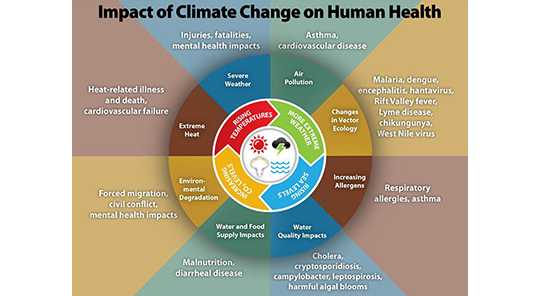Widespread scientific consensus exists that the world’s climate is changing. Some of these changes will likely include more variable weather, heat waves, heavy precipitation events, flooding, droughts, more intense storms, sea level rise, and air pollution. Each of these impacts could negatively affect public health. While climate change is a global issue, the effects of climate change will vary across geographic regions and populations. CDC’s Climate and Health Program is helping state and city health departments prepare for the specific health impacts of climate change that their communities will face. More »
Climate and Health News
New! Climate Change and Extreme Heat: What You Can Do to Prepare [PDF – 8MB]
New CDC and APHA Fact Sheets Describe How Climate Change Impacts Our Health
3rd National Climate Assessment: Human Health Chapter has been published
Intergovernmental Panel on Climate Change: 5th Assessment Report (AR5) is now available
CDC's Building Resilience Against Climate Effects (BRACE) Framework
CDC’s Climate and Health Program is the only HHS investment in climate change adaptation. We support state and city health department efforts to develop and pilot methods to adapt to the present and future health effects of climate change. Our program accomplishes this through funding provided to 16 states and two cities through the Climate Ready States and Cities Initiative (CSCRI). Funded states use the Building Resilience Against Climate Effects (BRACE) framework to identify likely climate impacts in their communities, potential health effects associated with these impacts, and their most at-risk populations and locations. BRACE helps states develop and implement health adaptation plans that impact health and address gaps in critical public health functions and services.
- Page last reviewed: December 23, 2014
- Page last updated: October 19, 2016
- Content Source:


 ShareCompartir
ShareCompartir




